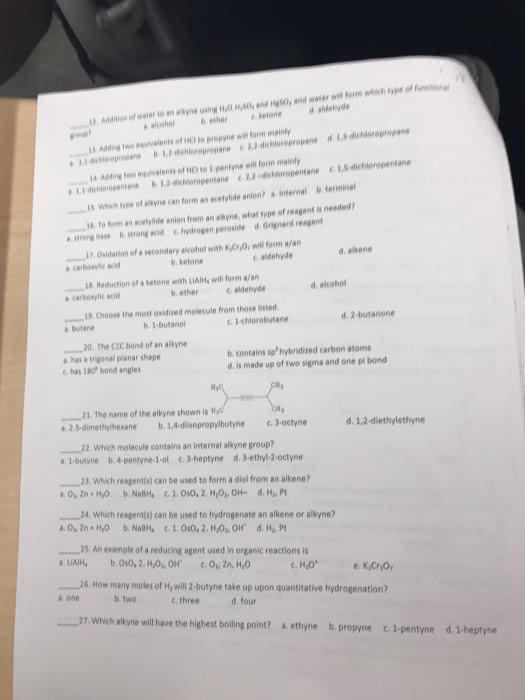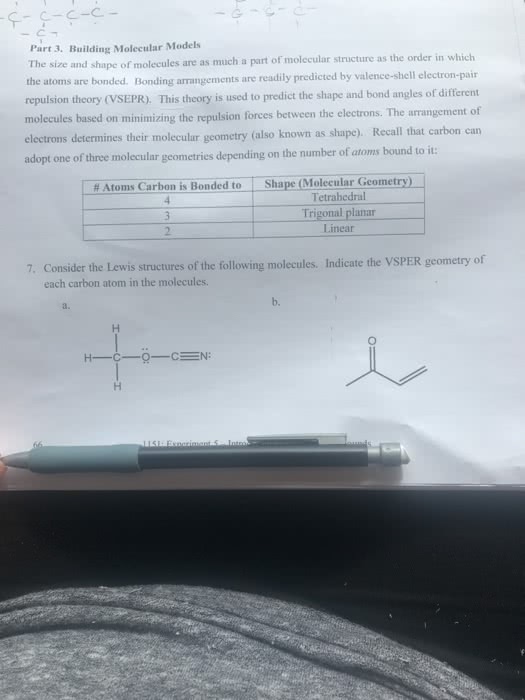CHEM 127 Lecture Notes - Lecture 1: Trigonal Planar Molecular Geometry, Sigma Bond, Cycloalkene

Organic Chemistry Chapter 10
10.1, Introduction
Alkenes are compounds that contain a carbon-carbon double bond.
Terminal Alkenes have the double bond at the end of the carbon chain, whereas
Internal Alkenes have at least one carbon atom bonded to each end of the double bond
Cycloalkenes contain a double bond in a ring
- The double bond of an alkene consists of one sigma bond and one pie bond. Each carbon is sp2
hybridized and trigonal planar, and all bond angles are approximately 120o
- Bond dissociation energies of the C – C bonds in ethane (a sigma bond only) and ethylene (one
sigma and one pie bond) can be used to estimate the strength of the pie component of the double
bond. If we assume that the sigma bond in ethylene is similar in strength to the sigma bond in
ethane (368 kJ/mol), then the pie bond is worth 267 kJ/mol.
- The pie bond is much weaker than the sigma bond of a C – C bond, making it much more easily
broken. As a result, alkenes undergo many reactions that alkanes do not.
- Cycloalkanes having fewer than eight carbon atoms have a cis geometry. A trans cycloalkene
must have a carbon chain long enough to connect the ends of the double bond without
introducing too much strain. Trans- Cyclooctene is the smallest, isolable trans cycloalkene, but it
is considerably less stable than cis-cyclooctene, making it one of the few alkenes having a higher
energy trans isomer.
find more resources at oneclass.com
find more resources at oneclass.com

-Properties of the Carbon-Carbon Double Bond
Property
Result
Restricted rotation
- The rotation around the C – C double
bond is restricted. Rotation can occur only if
the pie bond breaks and then re-forms, a
process that is unfavorable
Seteroisomerism
- Whenever the two groups on each end of a
C=C are different from each other, two
diasteromers are possible. Cis- and trans–2-
butene are diastereomers
Stability
-Trans alkenes are generally more stable than
cis alkenes
- The stability of an alkene increases as the
number of R groups on the C = C increases
10.2, Calculating Degrees of Unsaturation
An acyclic alkene has the general molecular foruma CnH2n, giving it two fewer hydrogens
than an acyclic alkane with the same number of carbons
- Alkenes are unsaturated hydrocarbons because they have fewer than the maximum number of
hydrogen atoms per carbon
- Cycloalkanes also have the general molecular formula CnH2n. Thus, each pie bond or ring
removes two hydrogen atoms from a molecule, and this introduces one degree of
unsaturation.
- The number of degrees of unsaturation for a given molecular formula can be calculated
by comparing the actual number of H atoms in a compound and the maximum number of
H atoms possible.
* Remember that for n carbons, the maximum number of H atoms is 2n + 2. This
procedure gives the total number of rings and pie bonds in a molecule
Example:
Calculate the number of degrees of unsaturation in a compound of molecular formula
C4H6, and propose possible structures.
[1] Calculate the maximum number of H’s possible
- For n carbons, the maximum number of H’s is 2n+2; in this example, 2(4)+2=10
[2]Subtract the actual number of H’s from the maximum number and divide by two.
- 10 H’s (maximum) – 6 H’s (actual) = 4H’s fewer than the maximum number.
4 H’s fewer than the maximum
2 H’s removed for each degree = two degrees of unsaturation
- A compound with two degrees of unsaturation has:
Two rings or two pie bonds or one ring and one pie bond
- This procedure can be extended to compounds that contain heteroatoms such as oxygen,
nitrogen, and halogen
Example:
1) Calculate the number of degrees of unsaturation for each molecular formula:
(a) C5H8O; (b) C6H11Cl; (c) C8H9N. Propose one possible structure for each compound
find more resources at oneclass.com
find more resources at oneclass.com
Document Summary
Alkenes are compounds that contain a carbon-carbon double bond. Terminal alkenes have the double bond at the end of the carbon chain, whereas. Internal alkenes have at least one carbon atom bonded to each end of the double bond. Cycloalkenes contain a double bond in a ring. The double bond of an alkene consists of one sigma bond and one pie bond. Each carbon is sp2 hybridized and trigonal planar, and all bond angles are approximately 120o. Bond dissociation energies of the c c bonds in ethane (a sigma bond only) and ethylene (one sigma and one pie bond) can be used to estimate the strength of the pie component of the double bond. If we assume that the sigma bond in ethylene is similar in strength to the sigma bond in ethane (368 kj/mol), then the pie bond is worth 267 kj/mol.




